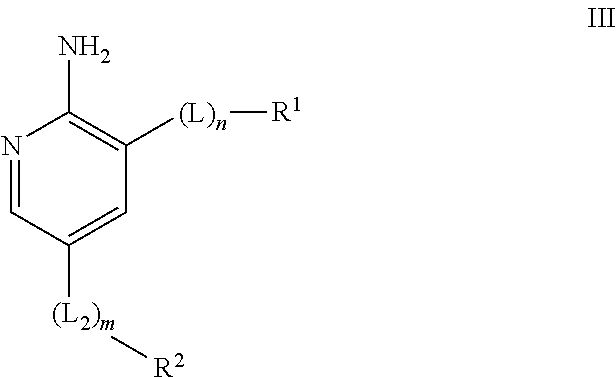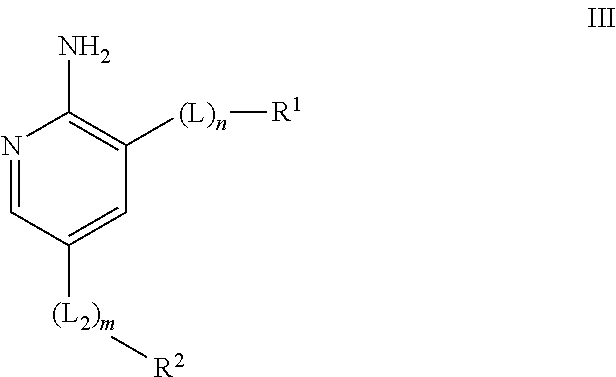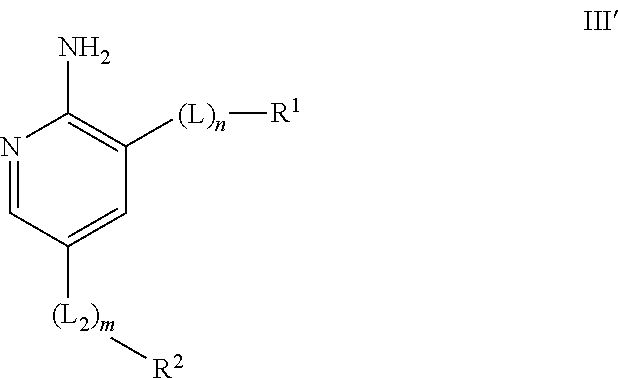Compounds useful as inhibitors of ATR kinase
a technology of atr kinase and compounds, applied in the direction of heterocyclic compound active ingredients, biocide, drug compositions, etc., can solve problems such as dna damage, and achieve the effect of surprising synergy
- Summary
- Abstract
- Description
- Claims
- Application Information
AI Technical Summary
Benefits of technology
Problems solved by technology
Method used
Image
Examples
example 1
2-Amino-N-phenyl-5-(3-pyridyl)pyridine-3-carboxamide (Compound III-7)
[0204]
Method A
Step 1: 2-Amino-5-bromo-N-phenylpyridine-3-carboxamide
[0205]
[0206]A mixture of 2-amino-5-bromo-pyridine-3-carboxylic acid (203 mg, 0.9354 mmol), aniline (87.11 mg, 85.23 μL, 0.9354 mmol), 1-methylsulfonylbenzotriazole (276.7 mg, 1.403 mmol) and DIPEA (241.8 mg, 325.9 μL, 1.871 mmol) in THF (2.0 mL) was heated in the microwave at 160° C. for 10 mins. The reaction mixture was concentrated and the residue partitioned between EtOAc and 2M NaOH. The organic phase was washed with brine, dried (MgSO4) and concentrated in vacuo to give the product as a yellow solid (174 mg, 64% Yield). 1H NMR (400.0 MHz, DMSO) δ 7.77 (br s, 2H), 8.18 (d, 1H) and 8.32 (d, 1H); ppm; MS (ES+) 293.94.
Step 2: 2-Amino-N-phenyl-5-(3-pyridyl)pyridine-3-carboxamide
[0207]
[0208]A mixture of 2-amino-5-bromo-N-phenyl-pyridine-3-carboxamide (230 mg, 0.5511 mmol), 3-pyridylboronic acid (74.45 mg, 0.6057 mmol), tetrakis(triphenylphosphine) p...
example 2
5-(4-(Methylsulfonyl)phenyl)-3-(5-phenyl-1,3,4-oxadiazol-2-yl)pyridin-2-amine (Compound III-3)
[0209]
Method B
Step 1: 2-Amino-5-bromo-N′-(phenylcarbonyl)pyridine-3-carbohydrazide
[0210]
[0211]TBTU (2.219 g, 6.912 mmol) and triethylamine (466.3 mg, 642.3 μL, 4.608 mmol) were added to a solution of 2-amino-5-bromo-pyridine-3-carboxylic acid (1 g, 4.608 mmol) and benzohydrazide (752.9 mg, 5.530 mmol) in DMF (40.00 mL) and the resulting solution stirred at ambient temperature over the weekend. The reaction was treated with water / EtOAc and the organics separated. The organic layer was washed with water (3×), dried (MgSO4), filtered and concentrated in vacuo to give a yellow oil which was triturated with ether and dried under high vacuum to give the product as an off-white solid that was used directly in the next step without further purification (1.177 g, 62% Yield). MS (ES+) 336.86.
Step 2: 5-Bromo-3-(5-phenyl-1,3,4-oxadiazol-2-yl)pyridin-2-amine
[0212]
[0213]Polyphosphonic acid (4.006 mL of 8...
example 3
5-(1-Ethylsulfonyl-3,6-dihydro-2H-pyridin-4-yl)-3-(5-phenyl-1,3,4-oxadiazol-2-yl)pyridin-2-amine (Compound III-4)
[0218]
Method C
Step 1: tert-Butyl 4-(6-(tert-butoxycarbonylamino)-5-(5-phenyl-1,3,4-oxadiazol-2-yl)pyridin-3-yl)-5,6-dihydropyridine-1(2H)-carboxylate
[0219]
[0220]A mixture of tert-butyl N-[5-bromo-3-(5-phenyl-1,3,4-oxadiazol-2-yl)-2-pyridyl]-N-tert-butoxycarbonyl-carbamate (300 mg, 0.5799 mmol), tert-butyl 4-(4,4,5,5-tetramethyl-1,3,2-dioxaborolan-2-yl)-3,6-dihydro-2H-pyridine-1-carboxylate (215.2 mg, 0.6959 mmol), dichloropalladium; triethylphosphane (12.00 mg, 0.02900 mmol) and Na2CO3 (184.4 mg, 1.740 mmol) in DMF (3.000 mL) was heated to 60° C. for 16 hours. Analysis indicated that there was starting material remaining so the reaction was heated to 140° C. in the microwave for a further 2 hours. The reaction mixture was allowed to cool to ambient temperature, diluted with DCM and water and the two layers separated. The organics were washed with 1M NaOH solution, dried (...
PUM
| Property | Measurement | Unit |
|---|---|---|
| temperature | aaaaa | aaaaa |
| temperature | aaaaa | aaaaa |
| temperature | aaaaa | aaaaa |
Abstract
Description
Claims
Application Information
 Login to View More
Login to View More - R&D
- Intellectual Property
- Life Sciences
- Materials
- Tech Scout
- Unparalleled Data Quality
- Higher Quality Content
- 60% Fewer Hallucinations
Browse by: Latest US Patents, China's latest patents, Technical Efficacy Thesaurus, Application Domain, Technology Topic, Popular Technical Reports.
© 2025 PatSnap. All rights reserved.Legal|Privacy policy|Modern Slavery Act Transparency Statement|Sitemap|About US| Contact US: help@patsnap.com



